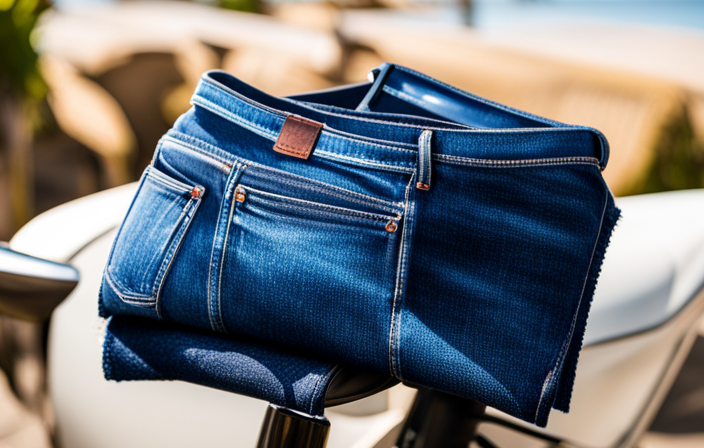As a cycling enthusiast, I’ve experienced how much a quality bicycle can impact your riding experience. However, the amount one should invest in a high-quality bike varies based on several considerations.
In this article, I’ll explore the different elements that affect the cost of a bicycle, so you can make an informed decision when it comes to your purchase. From the material of the frame to the type of brakes, there are many factors that can impact the price of a bicycle.
As you prepare to make your decision, it’s important to understand these variables and how they affect your ride. But don’t worry, I’ll break it all down for you in simple terms, so you can find a bike that fits your budget and your needs. So, let’s dive into the world of bicycles and discover what it takes to find a good one that won’t break the bank.
Key Takeaways
- Factors affecting the cost of a bicycle include the material of the frame, type of brakes, customization options, and brand reputation.
- Different types of bicycles, such as road bikes, mountain bikes, hybrid bikes, and commuter bikes, have unique features and price ranges.
- When choosing a bike, it’s important to consider budget, type of riding, expert advice, brand and model research, and additional costs like accessories.
- Balancing budget and quality is crucial, as cheaper entry-level models may have lower quality components and investing in a good bike can greatly affect performance and enjoyment of the sport.
Factors that Affect the Cost of a Bicycle
You’ll want to consider all the factors that’ll bump up the cost of your bicycle, like top-notch components and high-end materials. The customization options you choose can also add up quickly. For example, if you opt for a carbon fiber frame instead of an aluminum one, you’ll be adding a few hundred dollars to the cost.
Similarly, if you choose a high-end brand with a reputation for quality, you’ll be paying a premium for that name recognition. Brand reputation can also be a factor in the cost of a bicycle. A well-known brand with a reputation for quality will often charge more for their bikes. However, this doesn’t necessarily mean that lesser-known brands won’t offer a high-quality product at a lower price point.
Ultimately, it’s important to balance your desire for top-of-the-line components and materials with your budget constraints. With that in mind, let’s talk about budgeting for your bicycle purchase.
Budgeting for Your Bicycle Purchase
When budgeting for your bike, it’s important to keep in mind that the average cost of a mid-range bicycle is around $500. However, this cost can vary greatly depending on the type of bike you want, the materials it’s made from, and the features it includes.
It’s important to determine your budget before beginning your search for a bike, and to consider any additional costs such as bike accessories. Creating a bicycle budget can be a daunting task, but it’s important to stay realistic and consider all of your options.
Look for affordable bike accessories that can enhance your riding experience without breaking the bank. By doing your research and setting a budget, you can find a bike that fits your needs and your wallet.
Next, we’ll explore the different types of bicycles to help you understand which one is right for you.
Understanding the Different Types of Bicycles
When it comes to choosing a bicycle, it’s important to understand the different types available.
Road bikes are designed for speed and efficiency on smooth pavement, while mountain bikes are built for rugged terrain.
Hybrid bikes offer a mix of features from both road and mountain bikes, making them a versatile option for a variety of riding styles.
Commuter bikes are designed for daily transportation, with features like fenders and racks for practicality.
Road Bikes
If you want to ride a sleek and fast road bike, you’ll need to invest in one that costs at least a few thousand dollars. Road bikes are designed for speed and efficiency, with a lightweight frame and components that are optimized for smooth road surfaces.
The frame materials used in road bikes are typically carbon fiber or aluminum, which provide a balance between strength and weight. When it comes to bike components, road bikes often feature high-end parts that are specifically designed for racing or endurance riding.
This includes aerodynamic handlebars, lightweight wheels, and narrow tires that are optimized for speed. While you can certainly find cheaper road bikes on the market, these entry-level models typically have lower quality components and may not provide the same level of performance as a more expensive model.
Moving on to mountain bikes, these off-road machines have a completely different set of requirements and features.
Mountain Bikes
As for mountain bikes, these rugged rides require specialized components and features to tackle rough terrain and steep inclines. The best mountain bike brands offer high-quality bikes with durable frames and suspension systems, which can cost anywhere from $500 to $10,000 or more.
In addition to the bike itself, mountain bike accessories such as helmets, gloves, and padded shorts are essential for a safe and comfortable ride. When it comes to mountain biking, investing in a good bike is crucial as it can greatly affect your performance and overall enjoyment of the sport.
The cost of a mountain bike depends on the level of features and technology incorporated into the bike, as well as the brand and materials used. However, with proper maintenance and care, a good mountain bike can last for many years and provide endless opportunities for adventure on the trails.
Moving on to hybrid bikes, these versatile rides offer a combination of features from both road and mountain bikes.
Hybrid Bikes
You’ll love the versatility and adaptability of hybrid bikes, which combine the speed and efficiency of road bikes with the durability and stability of mountain bikes. Here are some benefits of hybrid bikes that make them a great choice for many riders:
-
Comfort: Hybrid bikes are designed with a more upright riding position, which makes them more comfortable for longer rides.
-
Durability: These bikes are built with sturdy frames and wider tires that can handle a variety of terrains, including paved roads and light off-road trails.
-
Speed: Hybrid bikes are faster than mountain bikes and more efficient than road bikes, making them a great choice for commuting or recreational riding.
-
Versatility: With a hybrid bike, you can easily switch between different types of riding, from commuting to weekend adventures on light trails.
When choosing the right hybrid bike for your needs, consider factors like your budget, the type of riding you plan to do, and the features that are most important to you. For example, if you plan to use your bike for commuting, look for models with fenders, racks, and lights. If you will be riding on rough terrain, consider a bike with wider tires and a suspension system. Ultimately, the right hybrid bike will depend on your individual needs and preferences.
As we move on to discussing commuter bikes, keep in mind that many of the benefits of hybrid bikes also apply to this type of bike.
Commuter Bikes
After learning about hybrid bikes, I realized that they can be a great option for those who want a versatile bike for both road and off-road riding. However, if you’re mainly using your bike for commuting, you may want to consider a commuter bike instead.
Commuter bikes are designed specifically for getting you to work or school quickly and efficiently, with features like fenders, racks, and lights already built in. One of the benefits of commuting by bike is that it’s a great way to stay active and save money on transportation costs.
But in order to get the most out of your ride, it’s important to choose the right accessories. For example, a good quality lock is essential to keep your bike secure while you’re at work or running errands. It’s also important to have a comfortable and well-fitting helmet, as well as lights and reflectors to ensure that you’re visible to drivers and pedestrians.
Now that we’ve talked about the benefits of commuting and choosing the right accessories, let’s move on to the next topic: shopping for a bicycle.
Shopping for a Bicycle
When shopping for a bicycle, I highly recommend researching different brands and models to find the best fit for your needs and budget.
Visiting local bike shops is also a great idea as they offer expertise and a chance to test ride different bikes.
Don’t forget to compare prices and features to ensure you get the best value for your money.
Researching Brands and Models
It’s common knowledge that finding a quality bike at a reasonable price can be a bit of a challenge, but delving into the world of different brands and models can lead to some great options.
When researching brands and models, it’s important to consider factors beyond the bike itself, such as the brand’s reputation for customer service and the availability of replacement parts. Comparing performance and durability is also crucial, as some brands may be better suited to certain types of riding or terrain.
One helpful resource for researching brands and models is online reviews from both professional and amateur cyclists. These reviews can provide valuable insight into the strengths and weaknesses of different bikes and brands, as well as any common issues or defects to look out for.
In addition, it’s always a good idea to visit local bike shops and talk to the staff about their recommendations and experiences with different brands and models. By doing your research and considering all the factors, you can make an informed decision and find a bike that will meet your needs and last for years to come.
Visiting Local Bike Shops
Exploring local bike shops can be an exciting and informative way to learn about different brands and models. When visiting a bike shop, it’s important to remember basic bike shop etiquette.
Greet the staff when you enter and let them know if you need any help or have any questions. It’s also important to be respectful of their time and not take up too much of it if you’re not planning on making a purchase.
Once you’ve found a bike that you’re interested in, don’t be afraid to negotiate the price. Most bike shops are willing to work with you on pricing, especially if you’re purchasing a higher-end model. However, it’s important to be reasonable in your negotiations and not try to lowball the shop.
By following these tips, you can make the most of your visit to a bike shop and find the perfect bike for your needs.
When you’re finished exploring local bike shops, the next step is to compare prices and features to ensure you’re getting the best deal.
Comparing Prices and Features
To find the best deal for you, you should compare prices and features of different bikes. When comparing prices, make sure to consider the quality of the bike as well. Some bikes may be cheaper, but they may not be as durable or have as many features as a slightly more expensive bike. It’s important to find the right balance between price and quality for buying a bicycle.
To help you compare prices and features, here’s a table that shows the average prices and features of three different types of bikes: a road bike, a mountain bike, and a hybrid bike.
| Bike Type | Average Price | Features |
|---|---|---|
| Road Bike | $1,000 – $3,000 | Lightweight frame, skinny tires, drop handlebars |
| Mountain Bike | $500 – $1,500 | Suspension, wide tires, flat handlebars |
| Hybrid Bike | $300 – $800 | Comfortable seat, medium tires, upright handlebars |
Remember to keep in mind your own needs and preferences when comparing prices and features. A road bike may be great for someone who wants to go fast and cover long distances, but not as comfortable for someone who wants to ride casually around town. With the right research and consideration, you can find a bike that fits your budget and your lifestyle. Next, let’s talk about how to maintain your bicycle.
Maintaining Your Bicycle
You’ll want to make sure you’re regularly checking the tire pressure and oiling the chain to keep your bicycle in top shape. Bicycle maintenance is an essential part of owning a bike, and it can save you a lot of money in the long run.
Some basic tips and tricks for maintaining your bicycle include keeping the tires inflated to the recommended pressure, cleaning and lubricating the chain, and checking the brake pads for wear.
When it comes to repair costs, it’s important to know what you’re getting into. Common repair costs for bicycles include replacing tires, brake pads, and chains.
DIY bicycle maintenance can be a cost-effective option, but it’s important to have the right tools and knowledge. Professional maintenance can be more expensive, but it can also save you time and ensure that your bike is properly maintained.
Ultimately, the choice between DIY and professional maintenance depends on your level of experience and comfort with bicycle repairs.
Frequently Asked Questions
What is the best brand of bicycles?
When it comes to top models, I highly recommend the brand Trek. Their bikes are reliable and have great customer reviews. Of course, the best brand for you ultimately depends on your personal preferences and needs.
How long does a bicycle typically last?
Bicycle lifespan depends on factors like usage frequency, terrain, and maintenance. Regular cleaning, lubrication, and tire pressure checks can extend the bike’s life. A well-maintained bike can last for several years.
Do I need special equipment to maintain my bicycle?
Hey there! Maintaining my bike is crucial for longevity. A few common issues like flat tires or loose brakes can be solved with basic tools and techniques. Keeping a tire pump, wrench, and lubricant on hand helps me stay on top of maintenance.
Is it better to buy a new or used bicycle?
When deciding between a new or used bicycle, there are pros and cons to consider. A used bike may be cheaper, but may require more maintenance. A new bike may come with a higher price tag, but may have better warranties and technology.
Can I customize my bicycle to fit my specific needs?
Yes, you can customize your bicycle to fit your specific needs. With bicycle customization, you can get a personalized bike fitting that suits your body type and riding style. Don’t settle for a one-size-fits-all approach.
Conclusion
So, after considering all the factors that affect the cost of a good bicycle, it’s safe to say that you should expect to pay between $500 to $2000 for a decent bike. However, you can always find a good quality used bike for a lower price if you’re on a tight budget.
It’s important to invest in a good bicycle that suits your needs and lasts for a long time. At the end of the day, the cost of a good bicycle is subjective and depends on individual preferences. As the saying goes, "you get what you pay for,"and this is especially true for bicycles.
By investing in a good quality bike, you’ll not only be making a long-term investment in your health and fitness but also in your overall quality of life. So, don’t hesitate to splurge a little on a good bike, because it’ll be worth it in the end.









